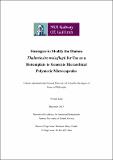| dc.contributor.advisor | Pandit, Abhay | |
| dc.contributor.author | Lang, Yvonne Mary | |
| dc.date.accessioned | 2014-02-19T12:58:48Z | |
| dc.date.available | 2014-02-19T12:58:48Z | |
| dc.date.issued | 2013-12-20 | |
| dc.identifier.uri | http://hdl.handle.net/10379/4198 | |
| dc.description.abstract | The aim of this research study was to generate a polymeric capsule with hierarchical architecture employing the diatom frustule as a sacrificial biotemplate. Both pennate and centric diatoms were isolated from Galway bay seawater. The diatom Thalassiosira weissflogii grew in a robust manner under laboratory settings and was selected for further characterisation and investigation. The architecture of the diatom was characterised using microscopy techniques and was conserved from generation to generation over a six-month culture period. Modification of the chemistry of the diatom was achieved by incorporation of either a titanium precursor or organoalkoxysilane precursor into the diatom during synthesis. The integration of the precursor into the diatom was confirmed using spectroscopic analyses. The presence of the precursor did not alter the gross morphology of the diatom. However, specific architectural features of the diatom, such as rib-like structures and pores, were altered. The final phase of this project involved fabrication of a polymeric capsule employing the modified diatom as a sacrificial core. The ability to alter the chemistry of the living diatom allowed the insertion of reactive moieties onto the surface of the diatom that would enable either in situ polymerization or deposition of a polymeric coating on the surface. Sequential deposition of poly(acrylic acid) (PAA) and poly(allylamine) hydrochloride (PAH) on the diatom surface, using layer by layer assembly, was performed to generate a PAA/PAH bilayer coating. Dissolution of the sacrificial diatom biotemplate yielded a free-standing PAA/PAH structure that retained the characteristic architecture of the diatom. Hence, this research project successfully modified the chemistry of the living diatom with subsequent replication to fabricate a polymeric microcapsule with hierarchical architecture. This characteristic elaborate architecture of the diatom has attracted the interest of material scientists for proposed applications in optics, catalysis, and drug delivery. This study is a first step in the implementation of diatoms in these applications. | en_US |
| dc.rights | Attribution-NonCommercial-NoDerivs 3.0 Ireland | |
| dc.rights.uri | https://creativecommons.org/licenses/by-nc-nd/3.0/ie/ | |
| dc.subject | Diatom | en_US |
| dc.subject | Biotemplate | en_US |
| dc.subject | Network of Excellence for Functional Biomaterials | en_US |
| dc.title | Strategies to Modify the Diatom Thalassiosira weissflogii for Use as a Biotemplate to Generate Hierarchical Polymeric Microcapsules | en_US |
| dc.type | Thesis | en_US |
| dc.contributor.funder | Science Foundation Ireland | en_US |
| dc.local.final | Yes | en_US |
| nui.item.downloads | 386 | |


